lock CHEVROLET BLAZER 1995 2.G Owners Manual
[x] Cancel search | Manufacturer: CHEVROLET, Model Year: 1995, Model line: BLAZER, Model: CHEVROLET BLAZER 1995 2.GPages: 380, PDF Size: 20.04 MB
Page 8 of 380
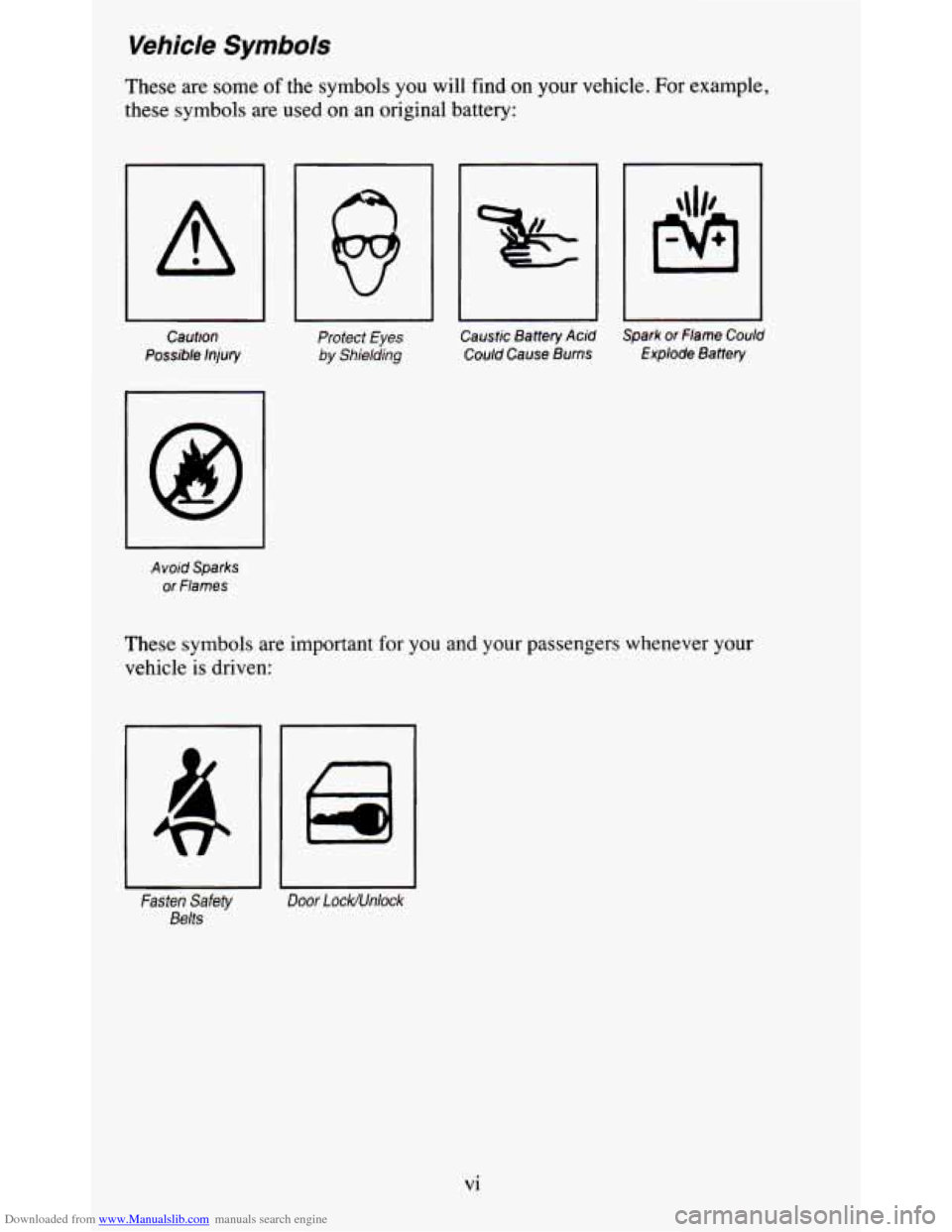
Downloaded from www.Manualslib.com manuals search engine Vehicle Symbols
These are some of the symbols you will find on your vehicle. For example,
these symbols are used on an original battery:
Caution
Possible
Injury
Protect Eyes
by Shielding
Avoid Sparks
or Flames
Caustic Battery Acid
Could Cause Burns Spark or
flame Could Explode Battery
These symbols are important for you and your passengers whenever your
vehicle is driven:
uu
Fasten Safety Door Lock/Unlock
Belts
vi
Page 10 of 380
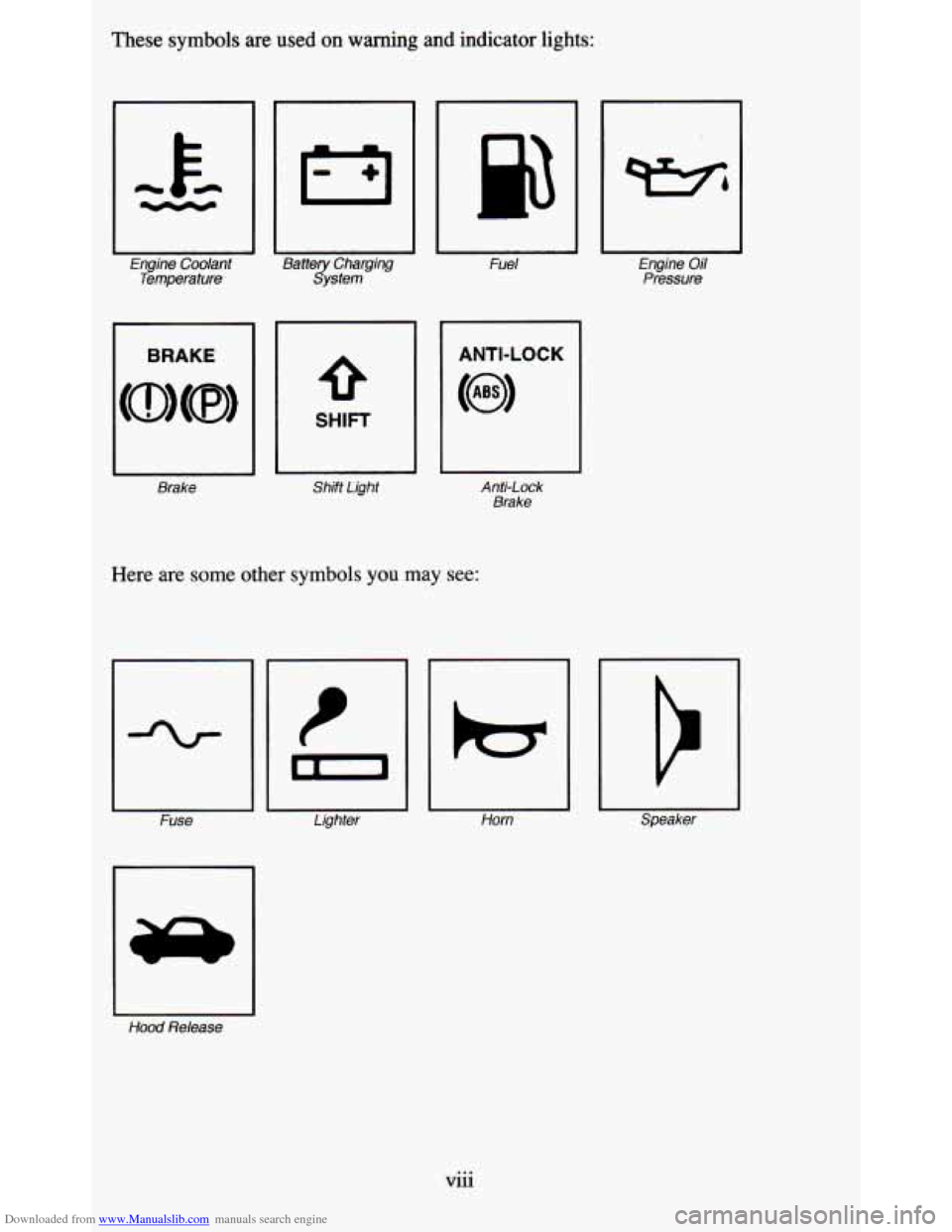
Downloaded from www.Manualslib.com manuals search engine These symbols are used on warning and indicator lights:
Engine Coolant
Temperature
I BRAKE
Brake
Battery Charging
System
1
Fuel
SHIFT
Shift Light
1 ANTI-LOCK
I
Anti-Lock Brake
Here are some other symbols you may see:
Fuse Lighter
I-
I-
Horn
L
Engine Oil Pressure
Hood
Release
Vlll ...
Page 12 of 380
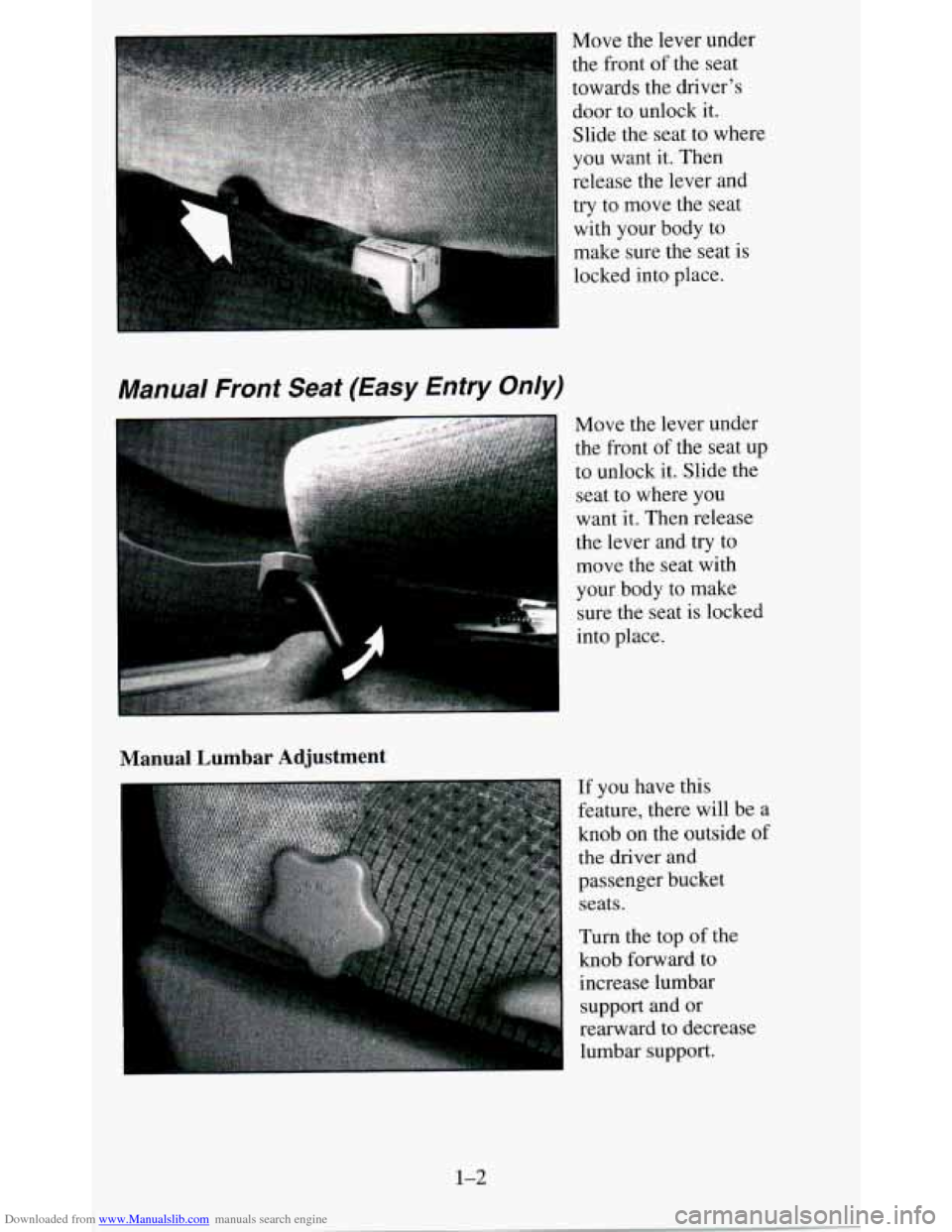
Downloaded from www.Manualslib.com manuals search engine Manual Front Seat (Easy Entry Only)
Move the lever under
the front of the seat
towards the driver's
door to unlock it.
Slide the seat to where
you want it. Then
release the lever and
try to move the seat with your body to
make sure the seat is
locked into place.
Move the lever under
the front of the seat up
to unlock it. Slide the
seat to where you
want it. Then release
the lever and try to move the seat with
' your body to make
-_ a, sure the seat is locked
into place.
Manual Lumbar Adjustment
If you have this
feature, there will be
a
knob on the outside of
the driver and
passenger bucket seats.
Turn the top
of the
knob forward to
increase lumbar support and or
rearward to decrease
lumbar support.
1-2
Page 14 of 380
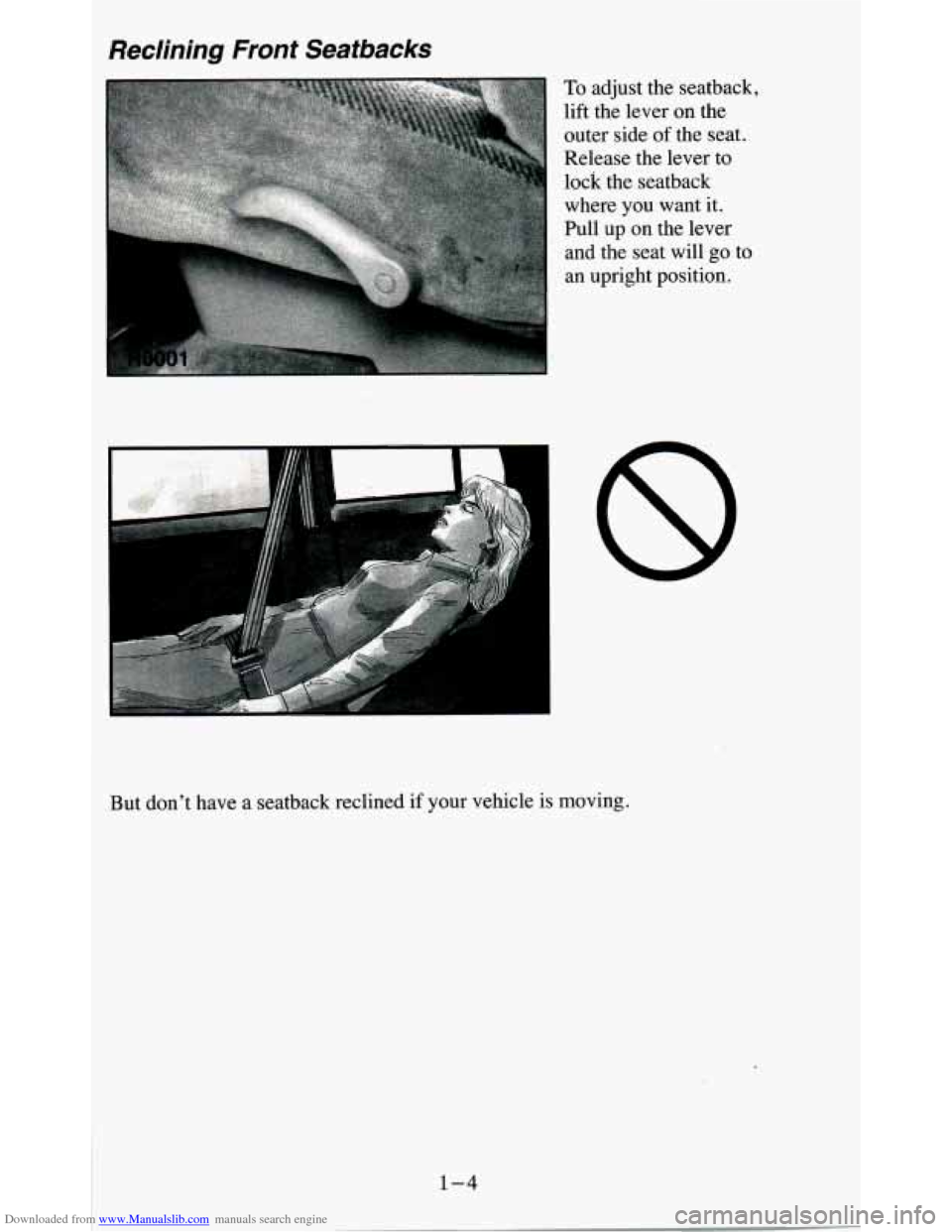
Downloaded from www.Manualslib.com manuals search engine Reclining Front Seatbacks
To adjust the seatback,
lift the lever on the
outer side
of the seat.
Release the lever to
lock the seatback
where you want it.
Pull up on the lever
and the seat will
go to
an upright position.
But don’t have a seatback reclined
if your vehicle is moving.
1-4
Page 15 of 380
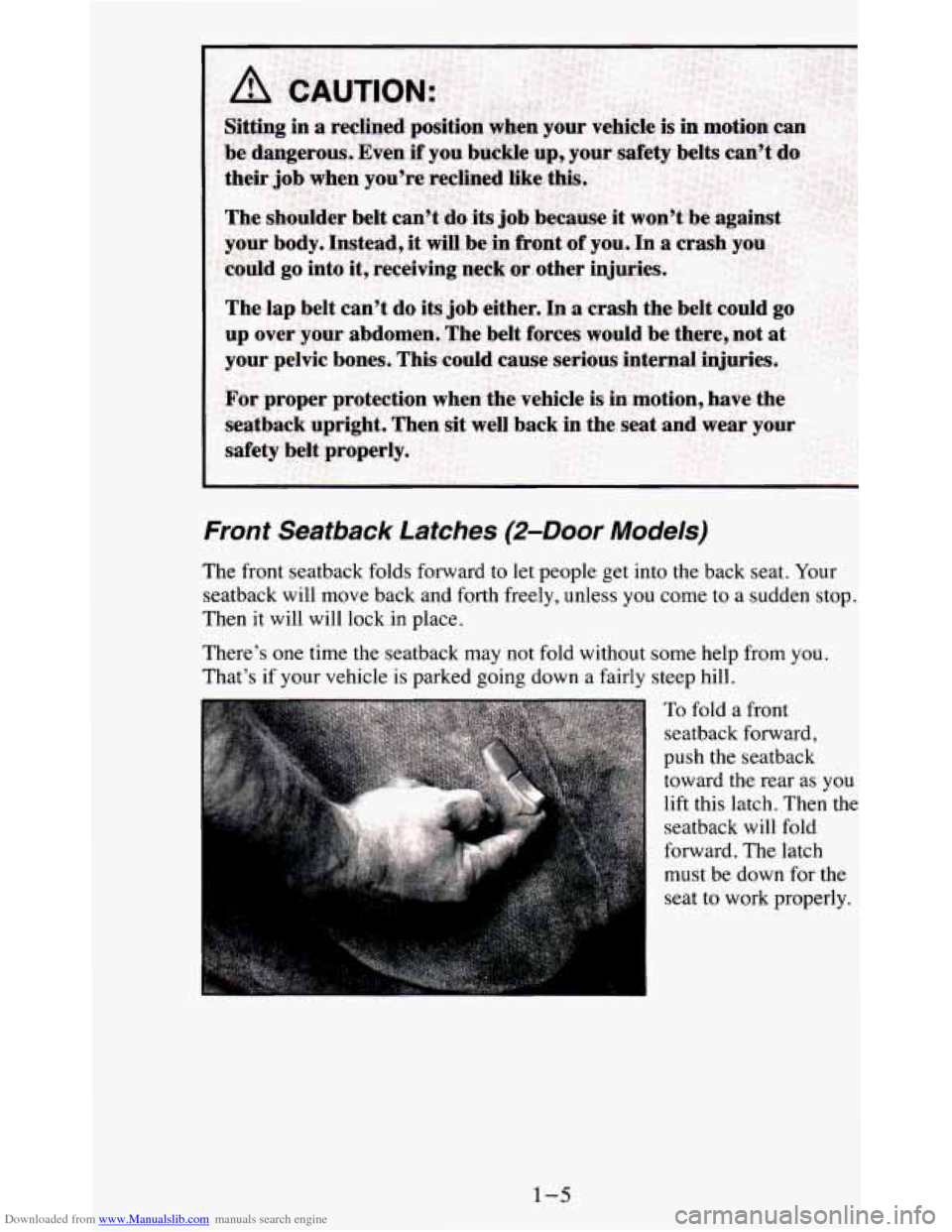
Downloaded from www.Manualslib.com manuals search engine Front Seatback Latches (2-Door Models)
The front seatback folds forward to let people get into the back seat. Your
seatback will move back and forth freely, unless
you come to a sudden stop.
Then it will will lock in place.
There’s one time the seatback may
not fold without some help from you.
That’s if your vehicle is parked going down a fairly steep hill.
To fold a front seatback forward,
push the seatback toward the rear as you
lift this latch. Then the
seatback will fold
forward. The latch
must be down for the
seat to work properly.
1-5
Page 16 of 380
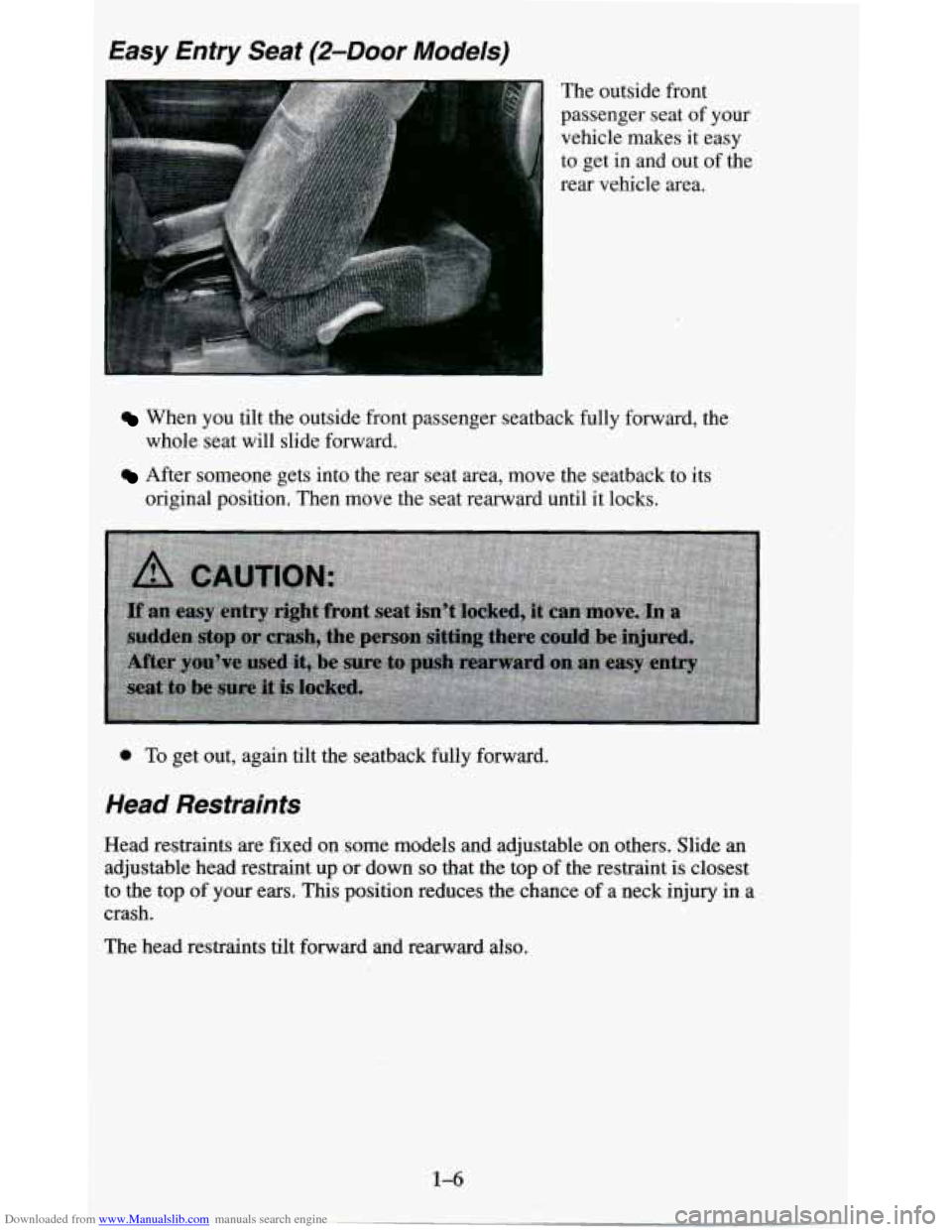
Downloaded from www.Manualslib.com manuals search engine Easy Entry Seat (2-Door Models)
The outside front
passenger seat of your
vehicle makes it easy
to get in and out of the
rear vehicle area.
When you tilt the outside front passenger seatback fully forwar\
d, the whole seat will slide forward.
After someone gets into the rear seat area, move the seatback \
to its
original position. Then move the seat rearward until it locks. \
0 To get out, again tilt the seatback fully forward.
Head Restraints
Head restraints are fixed on some models and adjustable on oth\
ers. Slide an
adjustable head restraint up or down so that the top of the restraint is closest
to the top
of your ears. This position reduces the chance of a neck injury in a
crash.
The head restraints tilt forward and rearward also.
1-6
Page 17 of 380
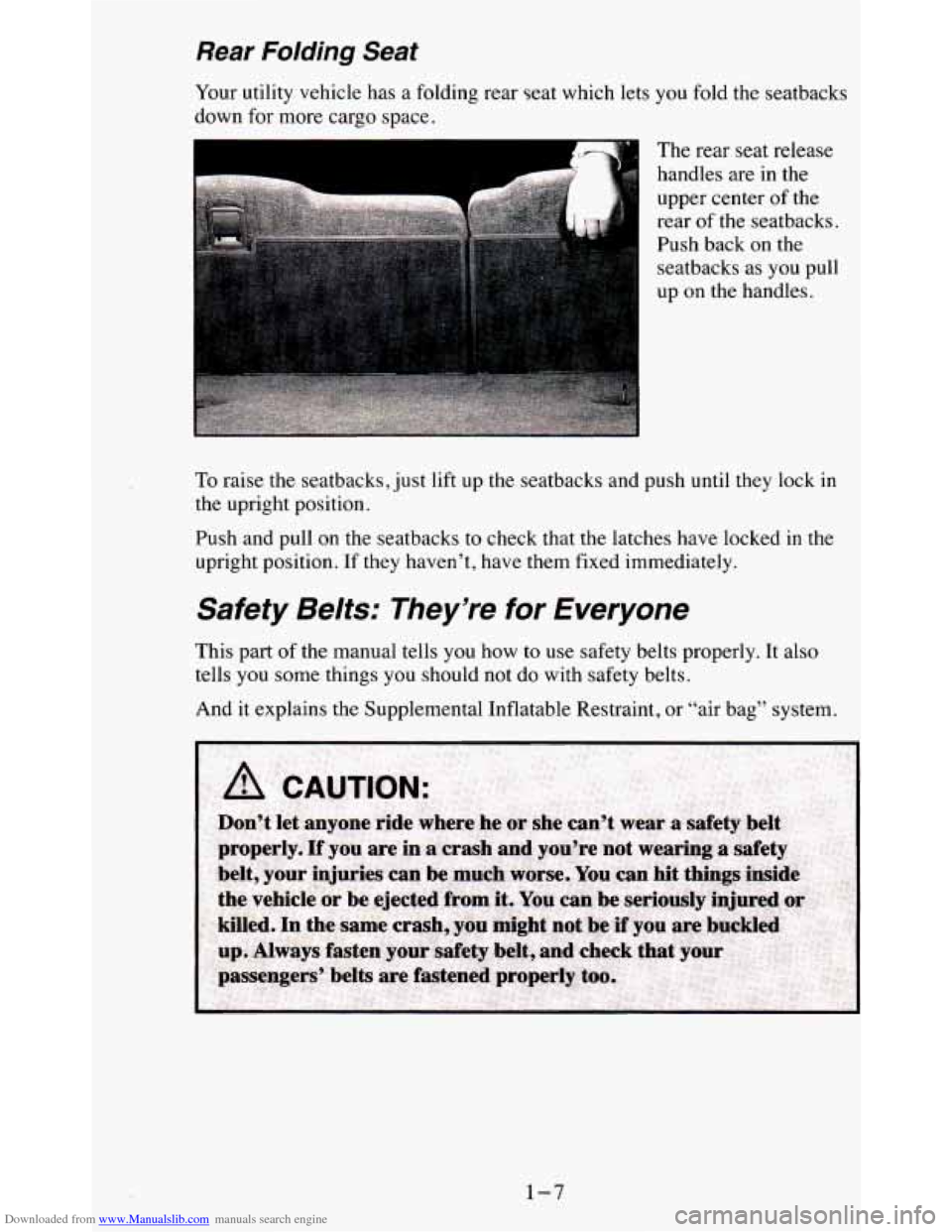
Downloaded from www.Manualslib.com manuals search engine Rear Folding Seat
Your utility vehicle has a folding rear seat which lets you fold t\
he seatbacks
down
for more cargo space.
The rear seat release
handles are
in the
upper center
of the
rear
of the seatbacks.
Push back on the
seatbacks as you pull
up
on the handles.
To raise the seatbacks, just lift up the seatbacks and push until they lock in
the upright position.
Push and pull on the seatbacks
to check that the latches have locked in the
upright position. If they haven’t, have them fixed immediately.
Safety Belts: They’re for Everyone
This part of the manual tells you how to use safety belts properly. It also
tells
you some things you should not do with safety belts.
And it explains the Supplemental Inflatable Restraint, or “air bag” system.
1-7
Page 22 of 380
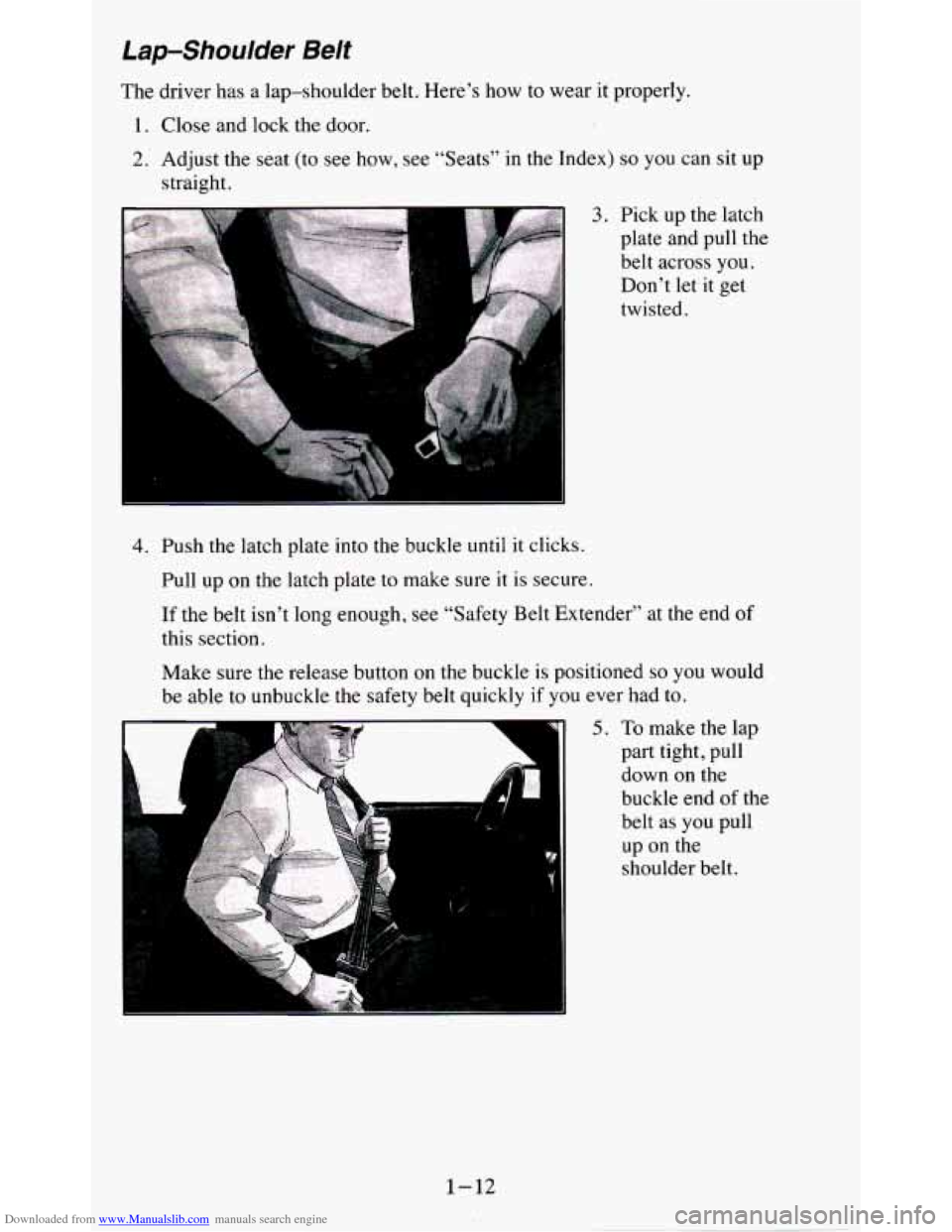
Downloaded from www.Manualslib.com manuals search engine Lap-Shoulder Belt
The driver has a lap-shoulder belt. Here’s how to wear it \
properly.
1. Close and lock the door.
2. Adjust the seat (to see how, see “Seats” in the Index) so you can sit up
straight.
3. Pick up the latch
plate and pull the
belt across
you.
Don’t let it get
twisted.
4. Push the latch plate into the buckle until it clicks.
Pull up on the latch plate
to make sure it is secure.
If the belt isn’t long enough, see “Safety Belt Extender” at the end
of
this section.
Make sure
the release button on the buckle is positioned so you would
be able to unbuckle the safety belt quickly if you ever had to.
5. To make the lap
part tight, pull
down on the buckle end
of the
belt as you pull
up on the
shoulder belt.
.
1-12
Page 23 of 380
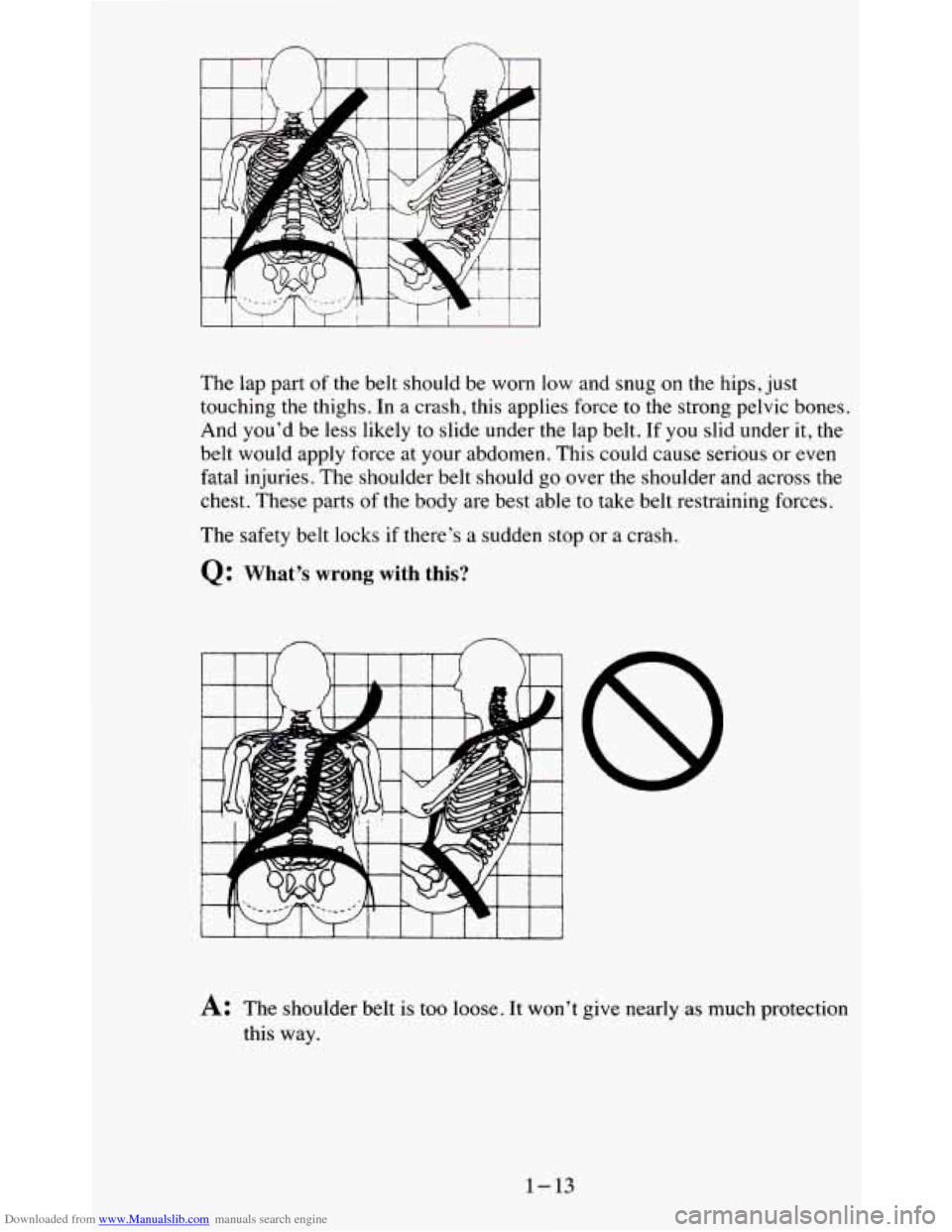
Downloaded from www.Manualslib.com manuals search engine The lap part of the belt should be worn low and snug on the hips, just
touching the thighs. In a crash, this applies force
to the strong pelvic bones.
And you'd be less likely
to slide under the lap belt. If you slid under it, the
belt would apply force at your abdomen. This could cause serious or even
fatal injuries. The shoulder belt should go over the shoulder and across the
chest. These parts of
the body are best able to take belt restraining forces.
The safety belt locks
if there's a sudden stop or a crash.
Q: What's wrong with this?
A: The shoulder belt is too loose. It won't give nearly as much protection
this way.
1-13
Page 32 of 380
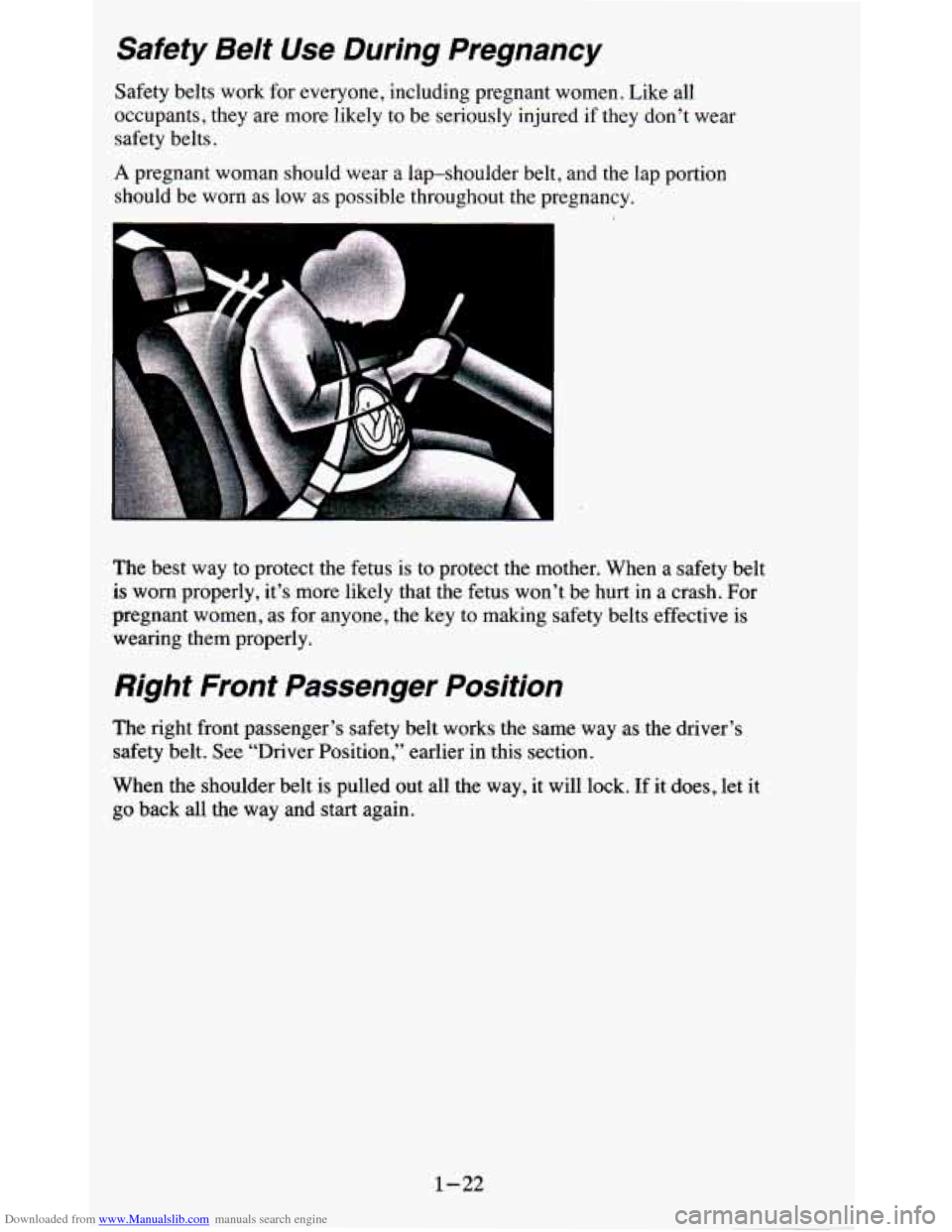
Downloaded from www.Manualslib.com manuals search engine Safety Belt Use During Pregnancy
Safety belts work for everyone, including pregnant women. Like all
occupants, they are more likely to be seriously injured if they don’t wear
safety belts.
A pregnant woman should wear a lap-shoulder belt, and the lap portion
should be worn
as low as possible throughout the pregnancy.
The best way
to protect the fetus is to protect the mother. When a safety belt
is worn properly, it’s more likely that the fetus won’t be hurt in a crash. For
pregnant women, as for anyone, the key to making safety belts effective
is
wearing them properly.
Right Front Passenger Position
The right front passenger’s safety belt works the same way as the driver’s
safety belt. See “Driver Position,” earlier in this section.
When the shoulder belt
is pulled out all the way, it will lock. If it does, let it
go back all the way and start again.
1-22